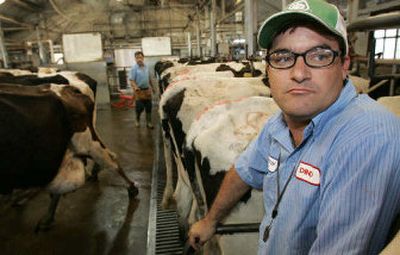Heat will fall next on consumers

FRESNO, Calif. — The triple-digit heat wave that steamrolled across the country this week killed thousands of cattle and poultry and cooked crops in the field before farmers could pick them. And experts say consumers will help foot the bill.
In California, the nation’s No. 1 agriculture and dairy producer, the temperature peaked at more than 115 degrees in late July, killing 16,500 cows, 1 million chickens and turkeys perished and countless peaches, nectarines, nuts and melons were destroyed.
As the heat plowed eastward, farmers in the Plains states and the Midwest also reported dried-out crops and lowered milk production.
“That’s the humbling part about agriculture,” said A.G. Kawamura, California’s secretary of Food and Agriculture. “We’re certainly vulnerable to a lot of factors.”
Because California produce is shipped worldwide, shoppers in far-flung places will probably help pay for the $1 billion blow the heat wave dealt to the state’s $33 billion agriculture industry.
“In certain areas you will see price spikes because of shortages,” Kawamura said. Dairy and canning tomatoes used for ketchup, salsa and spaghetti sauce were most affected but may show only a few cents increase.
Keith Collins, chief economist for the U.S. Department of Agriculture, said there’s strength in the size and number of America’s farms, and while some prices may go up, the damage has not been catastrophic.
“You have to keep in mind that this is a couple weeks in a season, in a long year, in an industry affected by many factors,” Collins said. “People may pay a few cents more for milk at the grocery store in the next few weeks, but overall it won’t be drastic.”
The most noticeable increase is likely to be on milk prices.
Production in California was 20 percent lower during the heat wave as the record-setting heat killed thousands of dairy cows, leaving farmers with piles of carcasses and creating a backup at factories that turn the dead animals into pet food. In California, officials in some counties confronted the problem by suspending rules that prevent livestock from being dumped in landfills.
The hot cows also ate less and produced less milk, even as farmers sprayed them with misters and fanned them down. Some of the milk they did produce was so low in fat and protein levels, it was “just white water,” one California dairy farmer said.
“The cows make the most milk when they’re the most happy, so we spend a lot of money trying to make them happy all the time,” said Dino Giacomazzi, a farmer whose family has operated a dairy in Central California since 1893. He doesn’t expect his cows to return to normal until December.
Farmers in the Midwest are using similar techniques to keep their cows cool. But Ohio farmers reported their animals have produced about 10 pounds less milk per day during the heat wave because of the heat, down from the usual 90 pounds.
Farmers were already making less money on milk this year. Doug Idsinga, a New Mexico dairy owner, was getting about $14 per pound for milk last summer, but only $10.50 per pound this month, he said.
Before the current heat wave, corn and soybean farmers in the Plains states and Midwest were anticipating a banner year. But the stifling temperatures created drought-like conditions. Late in the week, farmers were still waiting for things to cool off before taking stock of the damage.
Cotton, soybean and peanut crops across the Southeast were also stressed, Collins said.
“In parts of the South and in the West, there was already a drought effect,” he said. “Higher temperatures compounded existing problems in some areas.”
But most farmers east of the Mississippi were able to better cope with the heat because of recent rains and more available water.
Tobacco crops in Kentucky, where it rose to the high 90s, were expected to survive, though farmers were worried the high temperatures could burn some harvested leaf, causing a discoloration that reduces the crop’s quality.
California farmers lost about 1 million of the state’s 30 million chickens and turkeys under last week’s scorching temperatures, said Bill Mattos, president of the California Poultry Federation.
“Their profitability for this year is compromised,” he said.
Georgia, the No. 1 poultry state, suffered minor losses because the temperatures were not as severe as in the West, according to the Georgia Poultry Federation. Prices for Georgia chicken were average Thursday, according to the USDA.
The heat wave came at peak harvest season for fruit and nut crops in California, and farmers told of walnuts cooking inside their shells and melons scorched in the fields. But assessing the damage is hard because many farmers won’t know how they fared until after the harvest is over, Kawamura said.